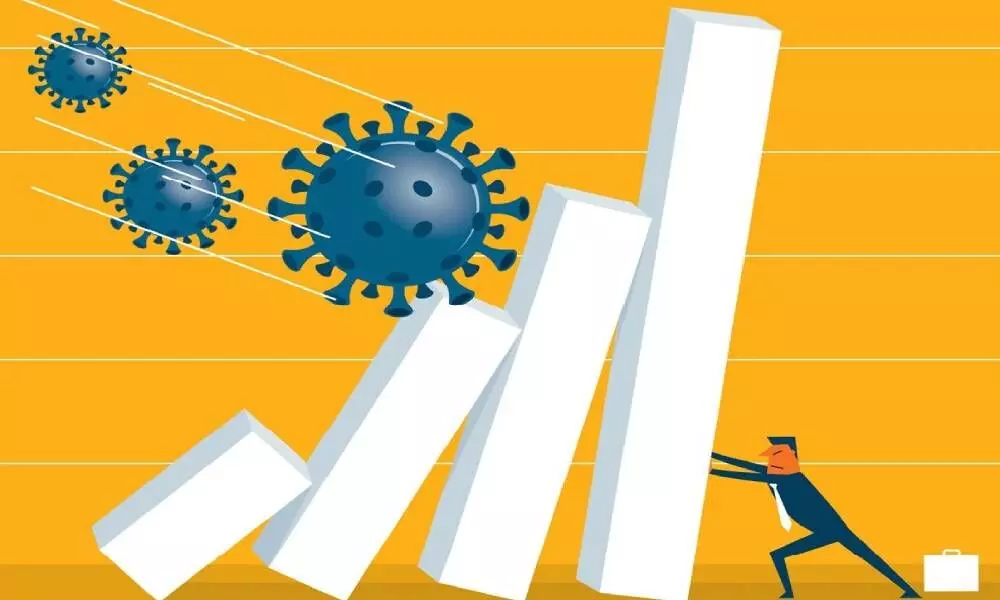Covid gobbles up 7.3% of economy in FY21
However; GDP clocks 1.6% upswing in Q4; India suffers first full-year contraction in the last 4 decades
image for illustrative purpose

New Delhi INDIA's economy contracted by less than expected 7.3 per cent in the fiscal year ended March 2021 after growth rate picked up in the fourth quarter, just before the world's worst outbreak of coronavirus infections hit the country. The gross domestic product (GDP) in Asia's third-largest economy grew by 1.6 per cent in the January-March period, up from 0.5 per cent in the previous quarter when India began pulling out of a steep pandemic-induced recession in the earlier six months.
GDP had grown by 3 per cent in the January-March quarter in the previous year. The economy, which was facing a slowdown even before the pandemic broke out last year, contracted by 7.3 per cent during April 2020 to March 2021 fiscal (FY21), weighed down by nationwide lockdown that pummelled consumption and halted most economic activities.
This is the first full-year contraction in the Indian economy in the last four decades since 1979-80, when GDP had shrunk by 5.2 per cent. The economy had grown by 4 per cent in the previous 2019-20 fiscal. The GDP expanded by 8.3 per cent in FY17 before slipping to 7 per cent in the following fiscal and to 6.1 per cent in 2018-19.
According to data released by the National Statistical Office (NSO), India's real GDP contracted to Rs 135 lakh crore in FY21 (2020-21) from Rs 145 lakh crore at the end of March 2020. To regain Rs 145 lakh crore size, the economy will have to grow by 10-11 per cent in the current 2021-22 fiscal but the outbreak of the second wave of Covid-19 infections last month has disrupted the momentum of economic activity and many expect the GDP may not touch double-digit growth rate despite the low base.
Even though daily Covid-19 cases have come down from a peak of over 4 lakh to 1.5 lakh, a crash in consumer demand -- constituting over 55 per cent of the economy -- and unemployment soaring to near one-year high of 14.73 per cent pose fresh challenges. Analysts have warned of risks to growth from slow pace of the four-month-old vaccination programme. While the NSO had previously estimated that the economy will contract by 8 per cent in 2020-21, the Reserve Bank of Inda (RBI) had projected a shrinkage of 7.5 per cent.
China, which was once the hotbed of coronavirus infections, has recorded 18.3 per cent economic growth in January-March 2021. Separately, higher tax collections helped arrest fiscal deficit (excess of government expenditure over revenue) at 9.3 per cent of the GDP in FY21 as against 9.5 per cent projected previously and 3.5 per cent estimated when the Budget was presented in February 2020.
Even before the outbreak of the pandemic, the fiscal deficit had soared to a seven-year high of 4.6 per cent of GDP in 2019-20 mainly due to poor revenue growth. The government has pegged the fiscal deficit during the current 2021-22 fiscal at 6.8 per cent of GDP.
Indian economy contracted by a record 24.4 per cent in April-June 2020 and by 7.3 per cent in the following quarter. The government had imposed a lockdown on March 25, 2020 to combat Covid-19. Later the lockdown restrictions were eased in phases. But it dented the economic growth eventually in the later period of the last fiscal. The Indian economy swung back to black in the October-December quarter.
According to the NSO data, gross value added (GVA) growth in the manufacturing sector accelerated to 6.9 per cent in the fourth quarter of 2020-21 compared to a contraction 4.2 per cent a year ago. Farm sector GVA growth was down at 3.1 per cent, compared to 6.8 per cent in the corresponding period of 2019-20.
Covid Casualty
- India's real GDP contracted to `135 lakh cr in FY21 from ₹ 145 lakh cr in FY20, a fall of `10L cr
- Unemployment soars to near 1-year high of 14.73% posing fresh challenges
- Outbreak of Covid 2nd wave in March disrupted the economic activity
- India needs to grow at 10-11% in FY22 to regain Rs145-lakh crore size
- Economists doubt the possibility of reaching double-digit growth rate despite the current low base as consumer demand worst-hit

